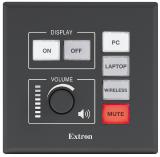BHSN Classroom 239
BHSN Classroom 239
Display
This classroom has a teaching station, connected to two interactive displays.o Mounted above whiteboard at the front of the room
o Projects onto dry erase whiteboard
o Mounted above whiteboard on side wall
o Projects onto dry erase whiteboard
- Resolution: 1920 x 1080 (Aspect Ratio 16:9)
Sources
The teaching station will provide multiple sources which can be shown on both projection screens:- HDMI cable with adapters for a mobile device (Laptop, tablet or smart phone)
- Wirelessly cast/mirror mobile device, using Airplay, Miracast, or Chromecast
Audio
- Ceiling speakers (main system)
- Volume control knob on Extron control panel
- Audio from devices connected beneath the projector on the side wall will instead utilize the projector's built in speakers
Equipment location
- Spectrum Link Lectern
Instructions
- Press the Display ON button to turn on the projectors. Remember to press the Display OFF button when you are done, to conserve energy and projector brightness.
- Press the button corresponding to your desired Source:
- If you want to use the provided desktop PC, select the PC button, wiggle the mouse, or press a key on the keyboard to wake the PC from sleep mode. If it does not wake, press the PC's power button to turn it on.
- If you want to use your own laptop or mobile device,
- with an HDMI cable: connect it to the provided HDMI cable, and if necessary, use the adapters on the adapter ring, or
- wirelessly connect.
- When you are through, press the Display OFF button, and reboot the computer. Leave all other devices powered on.
- If you want to use the projector on the side wall, connect your laptop or mobile device to the provided HDMI cable with adapters. Locate the projector remote and while aiming it at the projector, press the Source button. Use this same projector remote to control volume of any audio played back from your laptop connected directly to this side-wall projector.
- Use the volume knob to control the volume of any source connected at the teaching station at the front of the room.
- Use the Mute button to silence all audio of any source connected at the teaching station at the front of the room, and to blank any video being sent to the projectors from the teaching station at the front of the room.
Camera
- Document Camera: Connect the Hovercam to the computer using the orange USB cable. Use the buttons on the base of the HoverCam to Zoom in or out. Open the Camera app on the PC, and maximize the window.
- Also in Microsoft Teams, the Hovercam can be selected as a webcam or microphone input.
Wireless casting (from mobile device to display)
- Press the Wireless button on the control panel
- On the laptop, simultaneously press the Windows key and the K key. This brings up a list of display options on the right hand column.
- Select BHSN 239
- When prompted, type in the 4-digit code that appears at the top of the projection screen/whiteboard
- When done using the classroom technology, press Windows + K and deselect the option for BHSN 239. Then turn off the projectors, by pressing the Display OFF button on the control panel.
Showing different content on each projector
- The side projector can only show content from a laptop or mobile device connected to the HDMI cable which connects beneath that projector.
- At the front of the room, turn on the projectors using the Display ON button, on the Extron control panel.
- Select the source button for the content you want to show on the front display.
- At the side wall display, connect your laptop or mobile device to the provided HDMI cable with adapters.
- Then locate the Epson projector remote,
- Aim it at the projector and press the source button to auto-search for the connected device
- Use the same projector remote, aimed at the side-wall projector to control volume, of just that source. Do not use this to control the sound from the other devices connected at the front of the room. Use the volume knob on the teaching station to control that volume
- When you are through, unplug the laptop or mobile device from the HDMI cable. Using the Epson remote control, press the source button to auto-search for the connection from the front teaching station.
- Press the Display OFF button on the front teaching station control panel.

